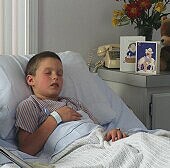- Skip Storing This Everyday Product in the Fridge Door
- Green Tea + B3 Pairing May Boost Brain Health
- Navigating Your Midlife Crisis: Embracing New Possibilities
- City Raccoons Showing Signs of Domestication
- Mapping the Exposome: Science Broadens Focus to Environmental Disease Triggers
- One Week Less on Social Media Linked to Better Mental Health
- Your Brain Changes in Stages as You Age, Study Finds
- Some Suicide Victims Show No Typical Warning Signs, Study Finds
- ByHeart Formula Faces Lawsuits After Babies Sickened With Botulism
- Switch to Vegan Diet Could Cut Your Greenhouse Gas Emissions in Half
Childhood Cancer Report Brings Mixed News


Progress has been made in fighting childhood cancer in the United States, but many challenges remain, a new report finds.
There will be an estimated 15,780 new cases of childhood cancer diagnosed this year, and 1,960 deaths from childhood cancer among patients aged 19 and younger, according to the American Cancer Society report.
The annual incidence of childhood cancer in that age group is 18.8 per 100,000, and about one in 285 youngsters will be diagnosed with cancer before age 20. Currently, about one in 530 young adults aged 20 to 39 is a childhood cancer survivor.
While advances in surgery, radiation therapy and chemotherapy have led to increased survival among childhood cancer patients, many of the survivors have a high risk of long-term health problems, said the report. It was published online Jan. 31 in CA: A Cancer Journal for Clinicians.
For example, survivors of childhood brain tumors may suffer difficulties such as seizures, hearing loss, blindness, weakness in the arms and legs, hormone imbalances, thyroid issues and decreased mental ability.
The report also noted that only a small percentage of childhood cancers have known, preventable causes, and that early detection of these cancers can be difficult because some symptoms are similar to those of common childhood illnesses.
“Progress in childhood cancer has been dramatic for some sites, but we cannot let that blind us from the fact that progress has been disappointingly slow for other sites, and that cancer remains the second leading cause of death in children,” Dr. Otis Brawley, chief medical officer at the American Cancer Society, said in a society news release.
“There is much work to be done to improve outcomes, to reduce side effects associated with cancer and its treatment and, we hope, to understand more about the molecular events that lead to childhood cancer in order to come up with ways to prevent or detect it early,” he added.
Jennifer Cullen, a cancer epidemiologist and a board member of the American Childhood Cancer Organization, wrote in an accompanying editorial: “We have seen successes for some [childhood] cancers, but others remain incurable and untreatable.”
The new report “is an essential inventory to help evaluate our progress and shortfalls” and shows “tremendous variation in survival and success rates across the different cancers affecting children,” she noted.
More information
The U.S. National Cancer Institute has more on childhood cancer.
Source: HealthDay
Copyright © 2025 HealthDay. All rights reserved.










